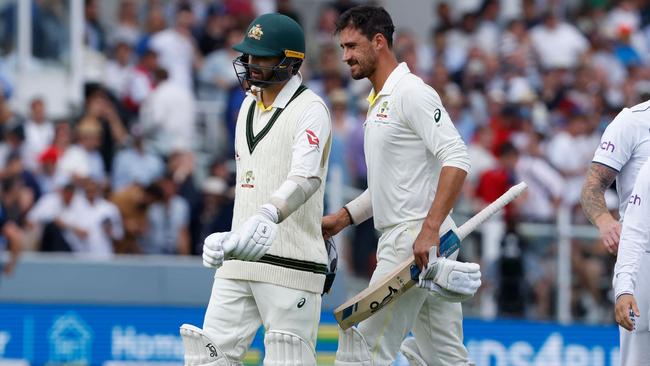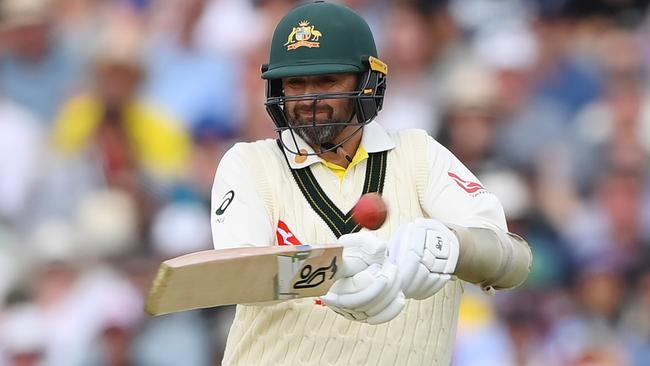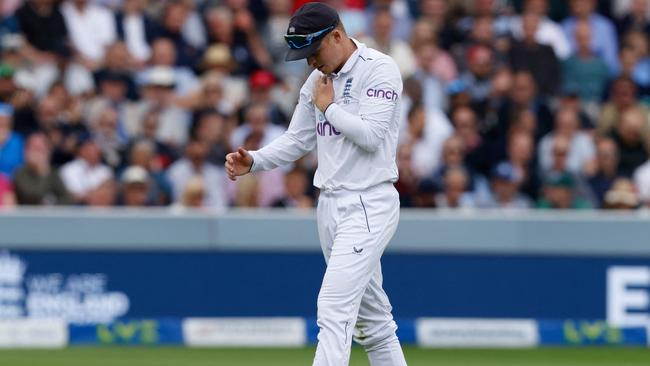Ashes 2023: Nathan Lyon’s heroics shine light on cricket’s weird sub rules
Nathan Lyon hopping down the steps in the Lord’s pavilion will be replayed for years. But it also highlighted cricket’s complicated and contradictory attitude towards substitutes.

Of all his involvements across 122 Tests, 100 of which have been consecutive, few if any moments featuring Nathan Lyon will end up being replayed more than the sight of him hopping down the last few steps in the Lord’s pavilion to a standing ovation on Saturday.
When Lyon limped off the home of cricket two afternoons earlier, and then needed crutches to make his way into the Australian rooms on Friday, the prospect that the off-spinner would feature again in this Ashes series seemed remote.
His calf injury was officially “significant,” and unofficially series-ending. But Lyon didn’t want to go out on that note. Given the chance, he would bat. That he did surprised Mitchell Starc, who looked to be jogging towards the pavilion when the wicket of Pat Cummins - Australia’s ninth - fell not long before tea on day four.
Australia already lead by 355, but Lyon had been on the wrong end of a similar chase at Headingley four years earlier. Any incremental addition to England’s target would be worth it. So he hobbled out to the middle, turned down any non-boundaries and even scored one off Stuart Broad himself.
Lyon and Starc put on 15 for the 10th wicket: two fours, a six, and a single. It was that lone one that was most dramatic. Starc pulled Broad to deep midwicket where Rehan Ahmed leapt to prevent a six, tossing the ball back into play. Having already committed to a mid-pitch meeting, Lyon was forced to painfully scamper the last few metres to complete the single.

It was toughness which shared parallels with Rick McCosker batting in the centenary Test with a broken jaw or Dean Jones’ battling through incontinence at Madras. It was the best of the baggy green.
But it also underscored cricket’s complicated, confusing and contradictory attitude towards substitutes. Because the man - albeit not long ago just a boy - who pulled off that bit of fielding on the rope, wasn’t part of England’s XI.
Teenage legspinner Rehan had been called into the hosts’ squad following Moeen Ali’s finger troubles. But England had opted for a seam-heavy attack, indeed Ben Stokes didn’t call on a single over of spin in Australia’s second innings, much of which was delivered in short balls in what proved a quaint throwback to Bodyline.
Ahmed was on the field though. And sub fielders remain commonplace, whether just for an over or two to relieve a player going to the bathroom, or when things are more serious, like in this case when Ollie Pope was sidelined because of a shoulder injury.
However as so often is the case in cricket, things aren’t as straightforward as they appear. Because having hurt his shoulder in the first innings, the England vice-captain came off the ground, was allowed to bat in his usual position at No. 3 in his side’s first dig, but was then told by officials that he could not do a second time in the match unless he fielded in Australia’s second innings. So he went out there, unsurprisingly further hurt his shoulder, and was then allowed to come off and still bat at first drop.

It was all a bit farcical, which admittedly fit the general trajectory of England’s series.
Cricket has a very curious relationship with replacement players. Historically it has been averse to them. It’s XI v XI, everyone has to bat, everyone has to field. But only to a point. It’s just that the location of that point seems to blow in the wind.
The underlying tension is between ensuring the sanctity of XI v XI isn’t exploited, but not forcing injured players to put themselves at greater risk.
Arjuna Ranatunga was infamously sledged by Ian Healy at the SCG in 1996 over the Sri Lankan captain being allowed a runner for cramp. While the finer points of Healy’s remarks are a point of contention, the essence was that Healy felt it unreasonable that the generously proportioned Ranatunga should be allowed a locum to get between the wickets quicker.
It was one of a litany of cases that lead to the runner being done away with in 2011. And it is why Starc’s handful of shots to boundary-riders on Saturday were marked in the scorebook as dots, with Lyon unable to get down the other end safely.
Yet four years ago in the corresponding Ashes Test, Steve Smith was subbed out of the game for Marnus Labuschagne after Smith was felled by Jofra Archer. Labuschagne became the first concussion sub in Test history. The idea behind it is sound: that teams should be incentivised to treat head injuries with caution and therefore allowed replacements.

There is a school of thought that the same mechanism should be available for any injury. That would be a slippery slope though. Just ask the AFL, which had to scrap a general injury sub rule at the end of last year after its integrity was challenged.
Perhaps more than anything, cricket’s real issue with substitutes is less about injuries and more about guarding against hyper-specialisation. That was ultimately the gripe of Ricky Ponting when he was run out by sub fielder Gary Pratt at Trent Bridge in one of the iconic moments of the 2005 Ashes.
But as Test cricket continues to ensure that an injured Australian No. 10 bats with his side already well ahead, the Indian Premier League has recently completed the first season in which it has featured tactical substitutions, in which teams name five substitutes before the game and have capacity to replace one player in the XI mid-match.
It is not a new concept in cricket. There was a briefly-lived “super sub” rule in one-day internationals, while the Big Bash toyed with the concept. It adds an interesting dynamic. As cricket continues to evolve, legislators should keep the cases of Lyon and Pope in mind when deciding which rules need substituting.







To join the conversation, please log in. Don't have an account? Register
Join the conversation, you are commenting as Logout